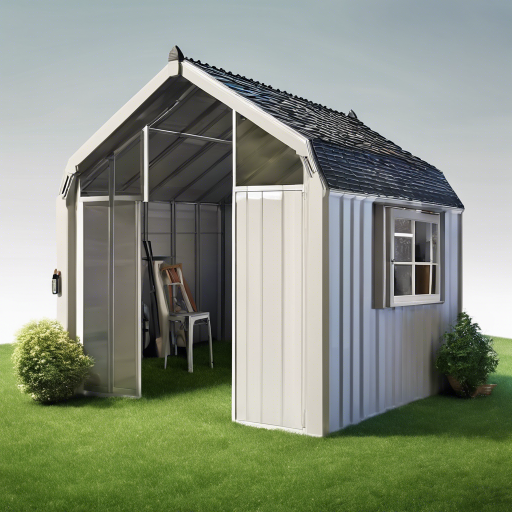Can a plastic shed go on grass?
Can a plastic shed go on grass?
When it comes to building sheds in your backyard, there are a few factors to consider. One of the key considerations is the type of surface where you plan to place your shed. Many people wonder whether a plastic shed can go on grass, and the answer is, yes, it can. However, there are a few things you should bear in mind before installing your shed on grass. This article will discuss the pros and cons of placing a plastic shed on grass and provide some tips on how to do it effectively.
Benefits of Placing a Plastic Shed on Grass
1. Cost-Effective Solution
One of the significant advantages of placing a plastic shed on grass is that it is a cost-effective solution. Plastic sheds are generally less expensive compared to other shed options like wood or metal. They offer a budget-friendly alternative without compromising durability and functionality. Since there is no need for additional foundation work, you can save money on construction materials and labor costs.
2. Easier Installation
Plastic sheds are lightweight and come with pre-drilled holes, making them relatively easy to assemble. Compared to sheds made of other materials, plastic sheds are often designed with interlocking panels that can be easily put together. This simplicity in installation saves time and effort compared to erecting a shed on a concrete or wooden surface.
3. Flexibility
Another advantage of placing a plastic shed on grass is the flexibility it offers. Grass is a forgiving surface that can adapt to the contours of your shed. This flexibility allows for easy repositioning of the shed if needed, and it can be moved without leaving permanent marks on the ground. This can be particularly beneficial if you are unsure about the best location for your shed or if you plan to rearrange your backyard in the future.
Considerations when Placing a Plastic Shed on Grass
1. Foundation Preparation
Although a plastic shed can be directly placed on grass, it is still essential to prepare the foundation properly. The goal is to provide stability and ensure that your shed remains level and secure. Begin by clearing the area of any debris, rocks, or uneven patches. Level the ground as much as possible to prevent any future shifting or sinking. Some people prefer using landscaping fabric or a weed barrier to prevent weed growth, but this is optional.
2. Base Support
To provide additional support and stability for your shed, it is recommended to use a base or platform. This can be a wooden or plastic frame made with pressure-treated lumber, or you can opt for a purpose-built shed base kit designed explicitly for plastic sheds. While it is not always necessary, especially for smaller sheds, a base will help distribute the weight of the shed more evenly and minimize potential damage to the grass over time.
3. Proper Drainage
Another crucial consideration for placing a shed on grass is proper drainage. Ensure that your chosen location has good natural drainage to prevent water accumulation around the shed, which could lead to damage or rot. If your chosen area tends to retain water or becomes swampy during heavy rains, you may want to consider improving the drainage by adding a layer of gravel beneath the shed or creating a slight slope to allow water to flow away from the structure.
4. Routine Maintenance
Placing a plastic shed on grass requires some routine maintenance to keep the area clean and prevent any issues. Regularly trim the grass surrounding the perimeter of the shed to prevent overgrowth, which can create moisture build-up and potential damage. Additionally, ensure that the area around the shed remains well-drained and free of debris or fallen leaves that may cause waterlogging.
Best Practices for Placing a Plastic Shed on Grass
To ensure the success of placing a plastic shed on grass, here are some best practices to follow:
-
Research Local Building Codes: Check with your local municipal office or homeowner's association to ensure there are no restrictions or regulations against placing sheds on grass in your area.
-
Choose the Right Size and Style: Consider the size of the shed you plan to install and ensure it fits within your available space. Take into account any future expansion or storage needs as well. Choose a shed that suits your backyard aesthetic and complements your existing landscaping.
-
Use Anchoring Systems: To secure your plastic shed even further, consider using anchoring systems. This will provide additional stability and prevent the shed from being easily moved by strong winds.
-
Ensure Adequate Ventilation: Plastic sheds may require proper ventilation to prevent condensation and maintain airflow. Check the manufacturer's recommendations for ventilation requirements and consider installing vents or windows accordingly.
-
Follow Manufacturer's Instructions: Always follow the manufacturer's instructions for installation and maintenance. This will ensure that your plastic shed remains in optimal condition and lasts for many years.
Conclusion
Yes, a plastic shed can indeed go on grass. Placing a plastic shed on grass offers many benefits, including cost-effectiveness, easier installation, and flexibility. However, it is essential to prepare the foundation properly, provide a base for support, ensure proper drainage, and perform routine maintenance. By adhering to these considerations and best practices, you can successfully install a plastic shed on grass and enjoy its functionality and practicality in your backyard.


